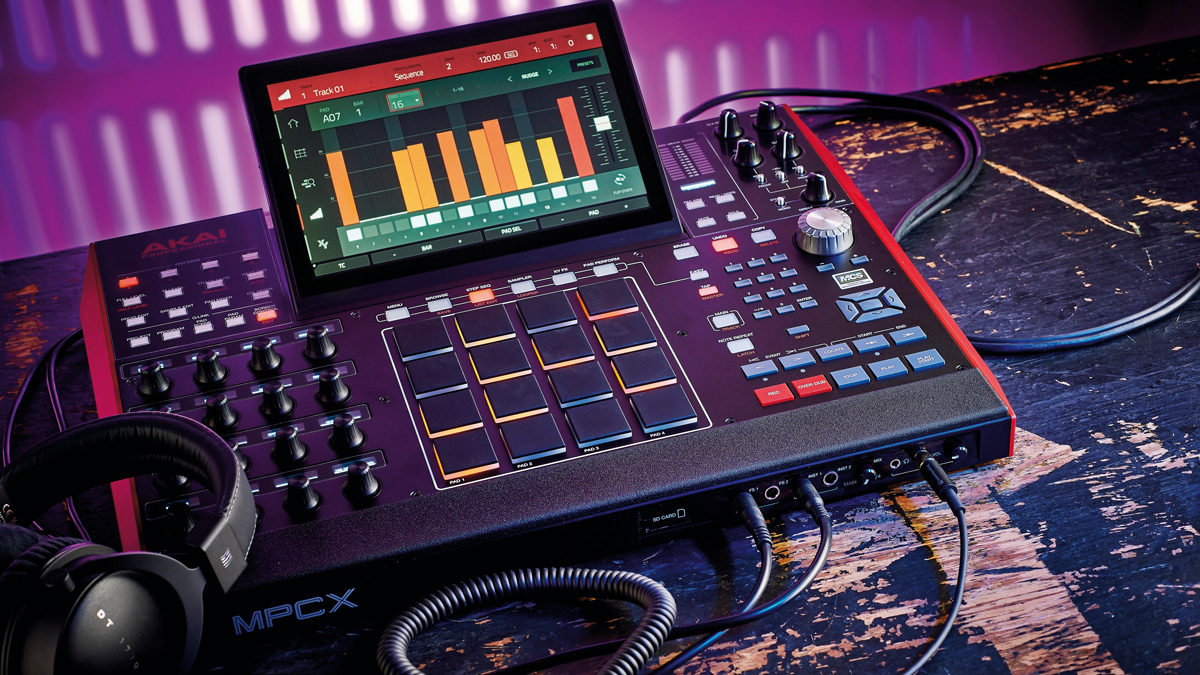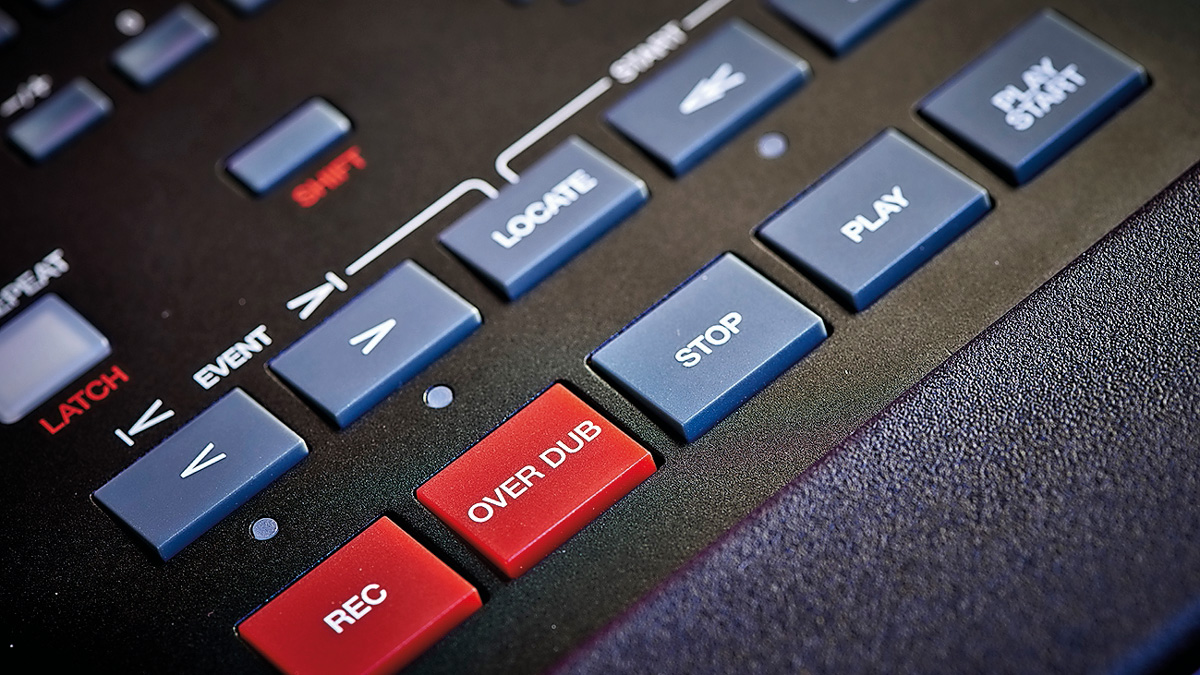MusicRadar Verdict
MPC X is hugely powerful, it works impressively standalone and as a controller, and it’s well on the way to replacing your DAW, live or in the studio.
Pros
- +
Audio engine and interface sound excellent.
- +
Few bugs and no crashes.
Cons
- -
Limited to 8 stereo audio tracks in standalone mode.
MusicRadar's got your back
We’ve been MPC-heads since the early noughties, starting off with the legendary MPC3000 then moving to an MPC1000 for live sequencing/triggering.
Having also reviewed the MPC Renaissance, Studio, Element/Essentials and more recently the MPC Touch, it’s now time to explore the new hybrid flagship: the MPC X!
Unlike the previous generation of MPCs, which were controllers for the MPC DAW software running on your computer, the MPC X (and its smaller relation MPC Live) are standalone units, essentially running their own embedded OS via built-in multi-core processor, with a 16GB internal drive and 2GB RAM. This provides a nicely integrated solution for running Akai’s latest 2.0 MPC software natively, and while there are a few notables missing from the standalone OS version (no external VST/AU plugins can be loaded in standalone mode and the hardware is currently limited to eight stereo tracks of audio), most of the key functionality remains.
The X is an imposing-looking machine and feels very solid throughout. The main body is metal with sleek red plastic sides, whilst the front has a squishy cushioned armrest for comfort whilst beat making.
The MPC X’s switches feel tough, the metal jog wheel feels sturdy and the touch sensitive metal, user-assignable Q-link dials feel high-quality with zero wobble. The super-clear Q-Link OLED displays are indispensable, showing the currently active Q-Link functionality, and the displays update instantly depending on what’s selected in standalone mode, plus the external plugin selected in controller mode.
Handily, you can also check any Q-link’s current value by gently resting your finger on any Q-Links’ capacitive surface.

Like all MPCs previously, the X has 16 thick rubber pads which are velocity and pressure sensitive, and the coloured backlights are a huge help for checking velocity levels, placement of events within your beats, and to denote the clip lanes in clip mode. These pads are the finest out there right now, and they allow extremely sensitive and precise expression. You also get eight pad banks to map your samples across.
Of course, you still have the indispensable ‘note repeat’ feature for quickly entering multiple events, and also the 16-Levels function for mapping sounds chromatically, by level, filter, decay and more. The only real downside to the X’s hardware is lack of battery power.
A rechargeable battery here would have made the MPC X fully self-contained like the MPC Live. However, Akai tells us it opted not to include one in order to keep the unit’s cost, size and weight down, which seems fair enough.
The MPC X is designed as a fully self-contained solution both live and in the studio - the idea is that it can replace your DAW as the hub of your setup. It can sequence samples residing internally and sequence MIDI hardware via the 2-in/4-out MIDI interface (like hardware MPCs of old), plus it now does audio warping, beat matching and clip launching.
You can record external audio/instruments (at 16-/24-bit quality) directly to the SD card or connected hard drive(s) via its built-in 4-in/8-out audio interface (via the great-sounding dual mic pres/line/ phono inputs), and the MPC X also fires CV/Gate out over its eight minijack outs.
In the studio you can use MPC X instead of your DAW and audio/MIDI interface for tracking and recording. Of course, you can still use it like an older hardware MPC for sampling and internal/external sequencing (of MIDI hardware), but now you can also use it as an eight-stereo-track hard disk recorder for capturing ideas quickly without switching on your computer (which is very liberating)! You can then combine this audio recording capability with your sampled beats, sequences and clips, whilst simultaneously triggering external MIDI and CV/Gate-equipped instruments, all without even entering controller mode! Once you’re happy, simply drop your audio and sequences into a song and arrange and mix within the MPC, then save your project to any connected drive and import into your DAW using the MPC DAW VST/AU plugin software for further tweaking/refining/mixing. Once you’ve mixed your tune(s), you can then export stems, or turn your audio tracks into shorter clips or samples for triggering from the pads. If you’re sick or wary of using computers on stage, then MPC X is a very viable alternative which is easy to travel with too.
You can also install your own SSD drive into the large SATA bay on the underside, or connect external drives and peripherals to the 2 USB-A ports. However, be aware that the MPC X’s internal drive (which comes with 10GB of content) isn’t readible by your computer. To move any of your content created on the MPC X between the hardware and MPC 2.0 (running within your DAW), you first need to save that content onto either your own SDHC, internal SSD or an external USB drive. Once the MPC X is in controller mode and detected by your computer, these drives will show up on your desktop.
The tiltable, multi-gesture 10-inch touchscreen is a great size, and works very smoothly. It’s very fast and responsive, and anyone used to using a tablet or smartphone will feel at home very quickly; this helps you get to grips with the deep functionality pretty quickly. It also features a multiposition stand which snaps closed against the back of the screen (so you can also use it flat), and when not in use, there’s a protective cover supplied, which slides right over the screen.
While the screen is pretty central to the MPC X’s workflow, the beauty is that you also have a huge number of hardware buttons and the aforementioned Q-Links for live performing or for directly accessing/editing all the main areas of the MPC software when using the machine standalone and when using the MPC to control the MPC software in controller mode, (when tethered to your computer and DAW).
Essentially, you’re getting the touchscreen experience, the hardware experience or both together, so there’s a lot of flexibility. Consequently, the X should appeal to both old MPC users and MPC virgins alike, though be aware that as there’s so much onboard in terms of functionality, the learning curve is fairly steep.
Importantly, the software is generally stable (the only bug we found was that the close tab doesn’t work on the effects page), and if you already know the MPC software, you’ll find the transition to the MPC X very smooth.

In use, the MPC X generally works great, and the new features such as the looper and step sequencer are brilliant. Sampling and chopping is a breeze - the MPC X will find all the transients in any recorded loop and swiftly map those chops to its pads.
Any audio can be instantly warped to fit any BPM, and the results are generally impressive. We also love the ‘slice’ feature which allows you to manually place your chops whilst in sampling mode.
Capturing audio is easy, and the quality of the X’s audio interface is excellent - clear, crisp and punchy, plus it drives nicely too! We plugged our Rhodes and bass into the front panel instrument inputs, set the gain, hit record and soon had an audio track recorded, which we could then chop and edit using the touchscreen and Q-Links.
There are a few areas that require Akai’s attention though. For editing audio, we’d love a way to connect a mouse to give a more DAW-like experience, but otherwise, deeper editing (though sometimes fiddly on the touchscreen) works well for most editing tasks. Also Akai, if you’re listening, please can we have Elektron-style parameter locking and conditional trigs and fills!
Now the acid tests... First we made a sequence with eight MIDI tracks firing out to our Roland JD-XA - all worked great: the timing was tight, and the feel (and swing) of the sequencer was on-point. Next we slaved the X to MIDI sync, coming from Logic via our AMT-8 MIDI interface. This worked pretty well, although there did appear to be some lag and slight inconsistency of timing each time Logic cycled around a loop (compared to slaving our MPC3000).
Our next major test was to see how the MPC X worked as a backing track machine using stereo stems bounced in Logic, then imported via SDHC card into the X. Whilst importing was a breeze, with five four-minute stems onboard, memory usage was already showing over half full, which left us scratching my head as these were only small MP3s.
It turns out, the MPC X auto-converts any imported files into larger WAV format and also, all audio and samples are loaded into the RAM (along with the OS), so as a backing machine for a live show with several longer stems across several tunes, you will really be pushing the limits of the MPC X’s 2GB RAM (which apparently can’t be upgraded). So, for the MPC X to be a serious live backing machine to replace a DAW, it’s essential that Akai implements disk streaming ASAP. Otherwise the workaround is chopping smaller loops out of your larger stems.
Despite these current limitations (which we’re hoping Akai can address), the MPC X is nonetheless very impressive and a truly viable DAW alternative. It’s a hugely powerful and solid machine that we wouldn’t hesitate to use for intensive studio duties and on stage as an alternative to a laptop. Let’s now hope that Akai gives this beastly machine the attention it deserves and unlock all its massive potential!
“Excels at unique modulated timbres, atonal drones and microtonal sequences that reinvent themselves each time you dare to touch the synth”: Soma Laboratories Lyra-4 review
“I used everything I knew about music”: How Green Day exceeded expectations with their most ambitious song
YouTube just added AI tools that makes musicians, library music and video editors redundant










